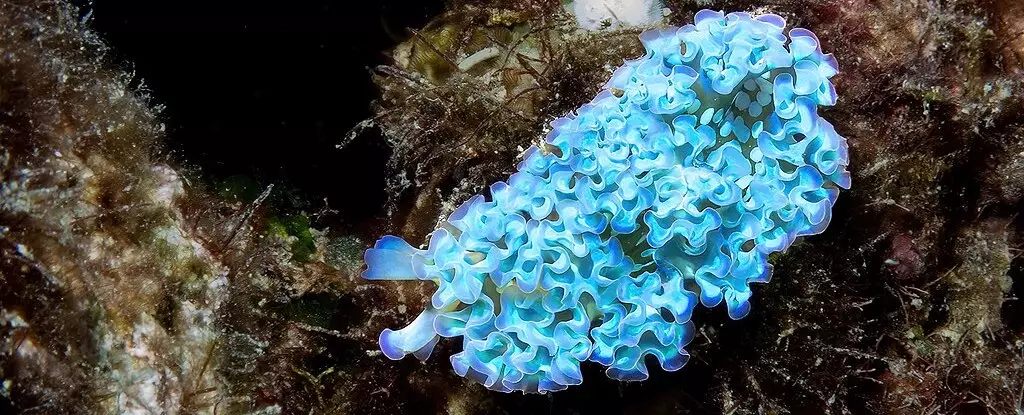In the kaleidoscopic underworld of the ocean, a creature exists that seems to defy the very principles of biology: the lettuce sea slug, or Elysia crispata. This seemingly innocuous mollusk, often mistaken for a fragment of underwater flora, possesses abilities that challenge our understanding of life itself. While typical organisms derive energy through the conventional avenues of digestion, the lettuce sea slug has carved out an unprecedented niche, one that blurs the lines between parasitism and symbiosis.
Imagine a tiny, vibrant being siphoning off the life force of another organism, showcasing an evolutionary strategy so cunning that it would seem more at home in the pages of a science fiction novel than in reality. The slug has mastered the art of kleptoplasty—the ability to hijack the chloroplasts of the algae it consumes, subsequently using them for photosynthesis. What the casual observer may see as a simple slug is, in essence, a living embodiment of cellular thievery that raises profound questions about the nature of life and coexistence.
The Science Behind the Slug’s Secret Weapon
The lettuce sea slug operates with a level of sophistication that leaves many scientists in awe. Recent studies have unveiled fascinating insights into the mechanisms that make kleptoplasty feasible. Rather than digesting the vibrant organelles it acquires, the slug cleverly encases them in structures dubbed ‘kleptosomes’ within its gut. These are not just mere villains in a biological soap opera; they serve a crucial purpose, keeping the chloroplasts operational and alive—balances the fine line between robbery and symbiosis.
Corey Allard, a cellular biologist affiliated with Harvard, likens the slug’s capabilities to something reminiscent of a fantastical character with superpowers. In a literal sense, the lettuce sea slug is accumulating a toolbox of abilities, siphoning energy from sunlight while simultaneously retaining the agility to digest food when circumstances demand it. Observations reveal that well-fed slugs radiate a fresh green hue, yet this vibrant color shifts to an alarming orange when sustenance becomes scarce. Such color changes are not simply aesthetic; they serve as warnings of undernourishment in a world rife with hardships.
Implications for Our Understanding of Evolution
The implications of the lettuce sea slug’s actions transcend beyond the novelty of eccentric marine life; they key into the broader narrative of evolutionary adaptation and symbiotic relations. For centuries, the concept of organisms gaining abilities through absorption has largely been theoretical, but this ‘marine burglar’ provides empirical evidence to tantalizing hypotheses. It invites scientists to explore how life forms can shift strategies in response to environmental pressures, evolving a level of interdependence that can potentially revolutionize entire ecosystems.
This also opens the door to considering the possibilities within our own biology. The general belief is that mitochondria—those vital powerhouses of our cells—were once free-living bacteria that formed a lasting relationship with primordial eukaryotic cells. This theory posits that the very source of energy within us could have originated from such rogue-like behavior. If the lettuce sea slug can repurpose stolen components from algae, why cannot we imagine a reality where organisms continually reshape their realities through similar methods?
The Ethical Dimensions of Marine Life Adaptation
As we delve deeper into the world of the lettuce sea slug, the ethical considerations emerge like shadows across a sunny reef. On one hand, nature’s brilliance in fostering adaptation through theft is enchanting; on the other, it raises questions about our role in a world dominant by evolutionary pressures. Are we, as humans, ethically positioned to initiate changes in our environment that could force species to adapt in ways that mimic the slug’s kleptoplastic cunning? Moreover, do we have the right to interfere in these natural processes, armed with technologies that can manipulate genetic material and thus change the course of evolution?
The lettuce sea slug is not merely an oddity; it is a harbinger of questions that resonate across disciplines. In the blend of biology, ethics, and philosophy, the slug stands as a testament to the intricate complexities of life. It urges us to reconsider our interactions with other living beings, as we remain in a precarious balance—a dance of survival where the line between stealing and collaborating is often imperceptibly thin.

